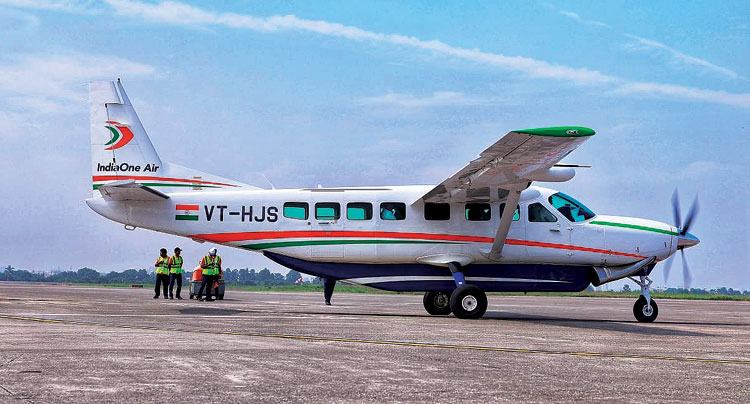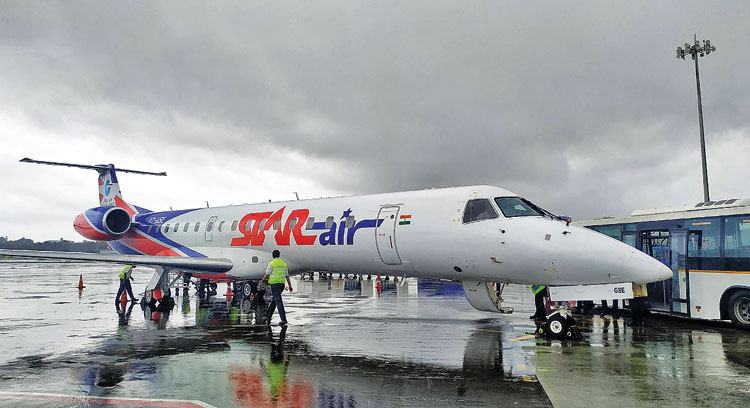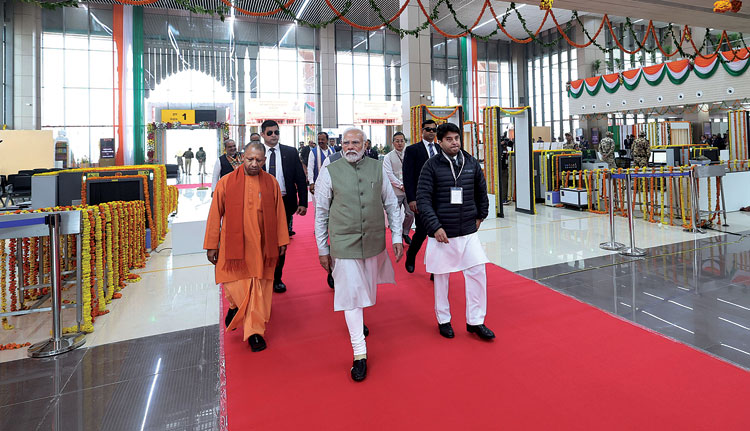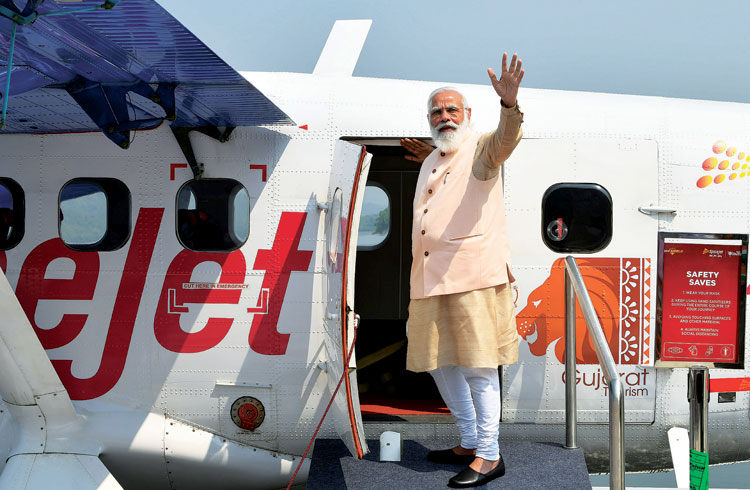Connecting Dreams, Transforming Lives
Six years since launch, the Regional Connectivity Scheme (RCS) continues to connect diverse regions through UDAN, empowering local communities and boosting economies

Everyone dreams of travelling on an aircraft at some point in their lives. Some achieve this dream while doing their jobs, some fulfil this dream as a part of their dream vacation with loved one’s but for many, especially the economically weaker sections of the society were getting one square meal is a daily struggle, this dream always just remains a dream. It is for such people that Prime Minister Narendra Modi had a focussed vision named–‘Regional Connectivity-UDAN scheme.’ This one-of-a-kind scheme was brought in to revolutionise air travel in India and completely change the picture of regional air travel. UDAN aims to enable air travel on underserved or unserved routes connection regional areas, promoting balanced regional growth and make flying affordable for the vast and economically poor section of the society.
THE BIRTH OF RCS UDAN - ‘UDE DESH KA AAM NAAGRIK’
In an important meeting held before the announcement of the National Civil Aviation Policy, Prime Minister Modi expressed his dream of seeing people wearing slippers on the plane as slippers (Chappal) is considered as a hallmark of a poor man in India. With this dream the UDAN scheme was launched as a vital element of National Civil Aviation Policy in October 2016. Within a year in April 2017, Prime Minister Modi, flagged off the first flight connecting Shimla to Delhi.
“First time in the country, dream of an air travel which is cheaper than taxi got realised. Small towns are connecting with big cities. A common man who travels in slippers, should also be seen in the aircraft. This is my dream,” said Prime Minister Modi and soon the UDAN scheme took wings.

Since then, till December 2023, 517 RCS routes have commenced operations connecting 76 airports, including nine Heliports & two Water Aerodrome. Going ahead the government plans to operationalise 1,000 UDAN routes and to revive/develop 100 unserved & underserved airports/heliports/water aerodromes by 2024 for operation of UDAN flights. About INR 3,751 crores have been utilised out of INR 4,500 crores allocated for the development of airports under UDAN.
IS UDAN SOLELY RESPONSIBLE FOR INDIA’S RISE IN AIR TRAFFIC?
“Given the strong GDP growth, with or without the scheme, air traffic in India would have increased anyway perhaps a shade lighter, but the growth would have been there,” comments Arun Kumar Singh, former Chief Executive and Accountable Manager of IndiaOne Air. He even shared some very interesting statistics.
In 2016 when UDAN was launched, the domestic air traffic was about 1,15,609 from scheduled and non-scheduled airlines. In the last 85 months, in November 2023 as per the latest data from Directorate General of Civil Aviation’s office the total number of domestic passengers rose by 52 per cent, 4,25,635 at a CAGR of 6.1 per cent. Comparatively, in September 2009, 85 months before UDAN kicked in, 1,15,609 domestic passengers were recorded. So, by general comparison between the months, in October 2016 traffic increased by 141.8 per cent at a CAGR of 13.3 per cent as compared to September 2009.
UDAN aims to enable air travel on underserved or unserved routes, connecting regional areas, promoting balanced regional growth, and making flying affordable for the economically poor
Thus, Kumar draws a simple conclusion from above figures that domestic air travel in relation to historic performance, over similar time period, growth rate has slowed down despite introduction of UDAN. According to Prem Garg, the current Chief Executive of IndiaOne Air, “UDAN was a good start but the overall progress is slow with sustainability issues for smaller standalone airlines. Code sharing model allowed but not working/feasible.” He further feels that UDAN has not lived up to its expectation of providing a sustained a competitive market environment in aviation sector.
Vineet Sood, Chief Executive Officer, Alliance Air differs in his opinion of UDAN. According to him: “RCS-UDAN scheme has definitely achieved its objective as flight connectivity has been provided between hinterland and the major metros. By operating flights on these routes people who had not travelled by air have started to travel in order to reduce the journey time,” he adds.
T. Kabilan I.D.A.S, Director of the NITI Aayog asserts that UDAN’s economic impact needs to be assessed objectively. “It is a good start though, but the necessary ecosystem needs to be prepped up by the states for adequate PPP infra in these areas,” Kaliban adds as an afterthought.
WHAT EXACTLY IS UDAN?
UDAN’s main focus is to connect small and medium cities to large metros through fixed wing aircraft. The affordable scheme has a fixed rate of INR 2,500 for one-hour journey by an aircraft or half hour journey by a helicopter for about 500 kilometres.
Aviation companies bid for air routes and the company that asks for the lowest subsidy is awarded the contract. In order to encourage airlines to start operations from unserved or underserved airports, heliports, water aerodromes, the government as well as airports offer financial incentives in terms of concessions to keep the air fare affordable. Selected airlines are offered financial support in the form of Viability Gap Funding (VGF). State governments provide 20 per cent while Northeast states and Union Territories offer 10 per cent VGF for RCS flights for their states.

Excise Duty at the rate of 1 per cent / 2 per cent is levied on Aviation Turbine Fuel (ATF) drawn by selected airline at RCS airports for RCS Flights for a period of 3 years from the date of commencement. However, in several cases, VAT and Excise on ATF is not exempted, reduction on operations charges like RNFC, Landing, Parking etc is not given while airlines are forced to pay money to third parties such as SITA.
“Airlines struggle on daily basis to claim their rightful dues, with the Airport Authority (AAI) turning a blind eye to airline’s requests,” Kumar retorts.
Thus, despite the subsidy offer, several airlines have either failed to launch operations or have abandoned the route after a while. Kumar explains the reasons for this with a three-point approach:
- MoCA and AAI have failed to put a cap on many viable routes that airlines can bid for.
- Due to this several airlines (in spite of being defaulters and not having the means to operate) bid for a high number of routes.
- Even if airline is in the position to commence flights, they are unable to do so since aerodrome is not licensed, navigation aid is missing, has high visibility requirement etc.
“RCS cell must be careful so as not to invite tenders for airports that are not ready for scheduled commercial operations,” Kumar signals a warning.
Echoing Kumar’s views Garg feels that infrastructure development, flexibility and VGF should focus on number of seats deployed in a quarter and not flights per week. According to Garg:
- eco system development for sustainability of routes after VGF support is withdrawn
- rationalisation of BGs and PGs for small operators
- single window for various applications for parking, space, hanger, stores, counters etc should be given.
Thus, delays in availability of required infrastructure/ airports, regulatory permissions for airline, capital intensive, cash flows, availability of licensed & experience manpower could be some of the reasons why airlines failed to take off on certain routes or abandoned the flights after a few months.
Another pain-point is the ‘network viability and aircraft utilisation’. “For financial viability, optimum aircraft utilisation needs to be more than 8 Block hours a day. You see our network, how our networks have been optimised and our aircraft utilisation for day operations,” Garg claims.
As a solution to the problem, Kaliban feels that route profitability and alignment to right subsidy structure may help newer airlines tide the issue of launching newer routes.
But all hope is not lost, certain airlines like Alliance Air has commenced all the routes awarded to it under RCS 5.0 round. Alliance Air boasts of starting maximum routes awarded to it since the inception of RCS-UDAN scheme. For example, Alliance Air has commenced 111 routes out of the 137 awarded to it. The flights which have not commenced are due to the airports are not being ready yet. “Once these airports are made operational, AAAL will commence flights at the earliest,” Sood adds.
Praising Alliance Air of the achievements Sood says, “It is noteworthy that Alliance Air has offered the maximum permissible capacity under airfare capping for the benefit of passengers on RCS routes. It is also encouraging that Alliance Air has not refused to operate any RCS route awarded to it. As on date, Alliance Air operates the highest number of routes under RCS.”
HOW HAS UDAN FARED IN REVITALISING ECONOMIES, INFRASTRUCTURE DEVELOPMENT?
UDAN has certainly helped to revitalise the local economies and given a big boost to the infrastructure in these cities. “But once the RCS tenure gets over, we see a dip in the travelling public,” says Sood. In spite of offering competitive fares and low fares the flights have not recovered their operational cost resulting in withdrawal of flights. “Alliance Air is already in touch with the government officials as well as State government officials to provide relief to the travelling passenger so that tourism and trade can be boosted,” Sood further clarifies.

Long term demand generation, sustainability and operational viability of the network after the VGF support is withdrawn is the key. “Ecosystem building in terms of Tourism, business, leisure and improved airport infrastructure is must. Small routes will have to be supported for longer duration (5-7 years) due scalability, operating costs for smaller airlines (less than 10 aircraft) consumer behaviour and operational factors,” demands Garg of IndiaOne Air.
“UDAN contribution to developing economies and infrastructure in Tier II and III cities can be called as debatable,” argues Kumar. “I started 5 airports in sort span of 10 months. I would have loved to fly with a bigger aircraft however, neither the State Government, nor the Central Government had the vision or the inclination to increase runway length or to make basic infrastructure available.”
Since its launch, 517 RCS routes have commenced operations, connecting 76 airports, with plans to operationalise 1,000 UDAN routes and revive/develop 100 unserved & underserved airports/heliports/water aerodromes by 2024
He further explains his point with a live example. “I was instrumental in getting Jeypore (Odisha) aerodrome licensed. Jeypore is in Koraput district, and for the first time, it got connect by air when we operationalised the airport.” Jeypore has a population of 1.5 million, houses HAL, NALCO and other mines. Despite the population, economy and potential, runway length in Jeypore is mere 1,200 meters. Kumar further goes on to express his frustration by saying that this runway length is not sufficient for ATR 72 aircraft; hence a 9-seater aircraft operates two flights a day to Jeypore. “This translates to only 0.005 trips per capita even if all flights go full the entire year. National average is 0.13 and for comparison, China is 0.5. Having airports with such small runways and feeble infrastructure is ‘too little too late’ and is like applying band-aid on a bullet wound,” Kumar adds with exasperation.
TAPPING THE SEAPLANE POTENTIAL

India’s vast and diverse coastline and inland lakes remain a treasure trove of untapped potential for the seaplane operations market. The Government of India is keen on exploring the potential of seaplane services in India. On October 31, 2020, the Prime Minister launched a seaplane service in Gujarat which showed that India is making progress in this segment. With the right market diligence, India’s long and a beautiful coastline offers the potential to develop both the tourism and transportation segments. India has several positive factors that could potentially benefit the seaplane operations market.
Few operators in India have demonstrated entrepreneurial initiatives and have tested the seaplane operations market in the past. SpiceShuttle, a subsidiary of SpiceJet, launched seaplane services using a 15-seater Twin Otter 300 aircraft. Spice-Jet had secured 18 seaplane routes under the UDAN scheme. Recently, an operator placed a substantial order for electric seaplanes that are planned to be launched in 2029. Hence with the right infrastructure and Governmental support, there are operators who are willing to test waters and start commercial feasible seaplane operations.
The Government of India and State Governments have taken initiatives in the past and continue to do so to promote seaplane operations. Under UDAN 5.0 (2023), the Ministry of Civil Aviation opened up more seaplane routes and also committed to developing seaplane waterdromes. Airport Authority of India (AAI) has sanctioned money for 14 water aerodromes in India. Also, Ministry of Ports, Shipping and Waterways has initiated the process of commencing operations of the Seaplane services, on the select routes. The model will be operated as a hub and spoke system. Further, Kerala Tourism carried out a detailed study to assess the locations and feasibility of seaplane operations within the State.
India has the right framework of regulatory, operations and Government support to explore the potential for seaplane services. With its vast and diverse geography and presence of large coastline and inland lakes, India has the potential to become a large seaplane operations market.
Kumar throws light on painpoints like super small runways, no navigation aid, DGCA AAI dragging their feet on GAGAN, stringent security regulations, X-Ray machine etc and unlicensed aerodromes which are huge bottleneck for operations.
Balancing demand and supply demand and commercial viability is a tight rope walk. One of the solutions provided by Kaliban to tide over this tussle is that newer and robust funding models in cost optimisation might help smaller airlines tide through the subsidy period.
WHAT CAN THE GOVERNMENT DO MORE FOR ‘AAM NAGRIK’ AND ‘AAM AIRLINES’?
Looking at BOMDEL as one route and DEL-BOM as another route, then in October 2016 about 304 domestic routes were operational. As per the current figures, in November 2023, total operational routes where at least one person travelled in the entire month was 600. “Now to achieve the target of 1,000 routes, there is a long-list of things that the Ministry of Civil Aviation (MoCA) needs to do,” says Kumar. He further goes a step ahead to list out all the to-do thing for the MoCA.
According to Kumar, “The MoCA should entirely revamp the UDAN scheme and take up some share of accountability for the airlines. Currently there is no ownership and accountability in the scheme. Airlines are left on their own to solve their problems.” Kumar goes on. He feels the DGCA norms are ambiguous, outdated and drafted keeping in view only the big aircraft.
Today sustainability is one of the most sought-after factors in aviation. Including sustainability as a core pointer in overall development is the need of the hour. “The global players have started it in a big way, its time Indian aviation also embraces sustainability in the aviation sector especially on the fuel front. There can be incentives for firms which bring in such innovation to the sky,” Kaliban concludes.
CHALLENGES FOR RCS-UDAN GOING AHEAD
Some of the current challenges observed are lack of infrastructure, low passenger demand, no benefit of cheaper tickets seen by passengers, and lack of awareness about the UDAN scheme, no dedicated platform to book the ticket under UDAN etc. However, Kumar correctly says that it is not government’s lookout to sell tickets. “I filled up 80 per cent of my flights despite not being on OTA / GDS. Government should only focus on policy formulation and infrastructure creation,” Kumar signs off Garg also feels that government is doing what it takes like collaborating with states and other ministries, businessmen, airports, airlines etc. Patting the MoCA on its back, Garg says: “MoCA & AAI RCS cell is doing good job trying to build up necessary expertise and getting operators on board for better coordination & collaboration.”
However, it’s healthy mix of infrastructure, use of technology for better reach, ease of business, faster & transparent system wherein cash flow is ensured. “Regulatory monitoring and impact evaluation of the scheme if done correctly will definitely help the ministry and the sector,” Kaliban signs off.





